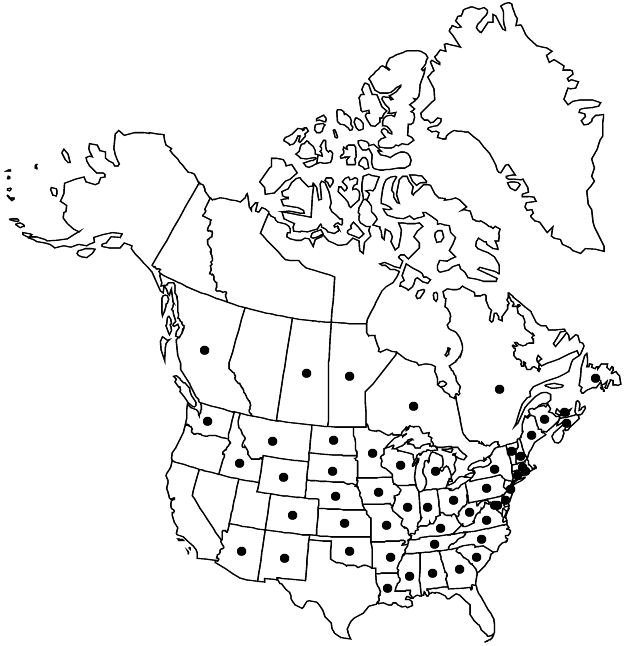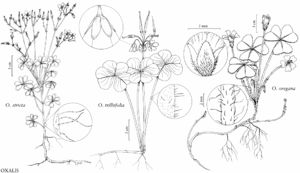Oxalis stricta
Sp. Pl. 1: 435. 1753.
Herbs annual or short-lived perennial, caulescent, rhizomes present, short, stolons absent, bulbs absent. Aerial stems 1 (–3) from base, erect or later leaning or falling over and decumbent, not rooting at nodes, 20–60 (–90) cm, herbaceous, villous, hairs ± straight, spreading, usually nonseptate and septate, septate hairs commonly concentrated at nodes, very rarely only nonseptate. Leaves basal and cauline; stipules rudimentary; petiole 2–8 cm, hairs septate and nonseptate; leaflets 3, light green to yellowish green, obcordate, (8–) 10–20 (–30) mm, lobed 1/5–1/3 length, surfaces glabrous, oxalate deposits absent. Inflorescences usually regular cymes, rarely irregular cymes, (1–) 5–7 (–15) -flowered; peduncles 3–9 (–11) cm. Flowers homostylous or slightly to strongly heterostylous, usually within or slightly above level of leaves; sepal apices without tubercles; petals yellow, without red lines, (6–) 8–11 mm. Capsules ± cylindric, nearly terete, abruptly tapering to apex, 8–15 mm, villous to puberulent or glabrate, hairs septate. Seeds brown, transverse ridges rarely white. 2n = 18, 24.
Phenology: Flowering (Apr–)Jul–Oct.
Habitat: Prairie ravines, riverbanks, sandbars, low woods, mesic forests, floodplains, roadsides, fields, lawns, gardens.
Elevation: 20–1200 m.
Distribution

B.C., Man., N.B., Nfld. and Labr. (Nfld.), N.S., Ont., P.E.I., Que., Sask., Ala., Ariz., Ark., Colo., Conn., Del., D.C., Ga., Idaho, Ill., Ind., Iowa, Kans., Ky., La., Maine, Md., Mass., Mich., Minn., Miss., Mo., Mont., Nebr., N.H., N.J., N.Mex., N.Y., N.C., N.Dak., Ohio, Okla., Pa., R.I., S.C., S.Dak., Tenn., Vt., Va., Wash., W.Va., Wis., Wyo., in Europe, Asia, Africa, Pacific Islands (New Zealand), Australia
Discussion
Oxalis stricta is uncommon and probably adventive in Canada and the western United States. The species is recognized by the combination of its tall (rarely up to nearly a meter), erect stems from a short, simple rhizome; septate hairs; cymose inflorescence; and small flowers. Septate hairs on the stems and petioles are easily recognized (lens) by their colored cross-walls, but they vary greatly in density. In villicaulis forms, the hairs are dense and evenly distributed, but in most plants over the range they are localized around the nodes and intermixed with nonseptate hairs. Often they are sparse; rarely they appear to be absent on plants with greatly reduced vestiture overall.
A. Lourteig (1979) identified this species as Oxalis fontana, typified by a plant from northern China, and applied the name O. stricta to the species identified by G. Eiten (1955, 1963) and here as O. dillenii. The basis for the difference lies in selection of lectotypes. Choice of stricta as the correct epithet acknowledges that the description of O. stricta by Linnaeus best matches these plants and that selection of a Morison illustration as lectotype characterizes the species long-naturalized and weedy in Europe and probably known first-hand by Linnaeus. C. E. Jarvis (2007) has confirmed this choice of lectotype. Oxalis dillenii is appropriately lectotypified by a John Clayton collection from Virginia. The situation has been summarized well by D. B. Ward (2004).
Selected References
None.
Lower Taxa
"alternating" is not a number."/5" is not declared as a valid unit of measurement for this property.
